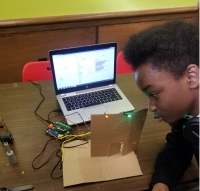System-Wide Youth Technology Education Initiative
New York Public Library, N.Y.
Innovation Synopsis
In 2017, NYPL launched a system-wide education initiative to increase the quantity and quality of tech programs offered to youth in topics such as coding, robotics, digital music creation and 3-D printing. Our team has developed a program model and staff training approach that supports librarians in cultivating STEAM identities in NYC youths.
Challenge/Opportunity
Youth librarians’ roles have transformed as libraries are increasingly viewed as educational institutions. They must be experts in library sciences, early childhood and facilitating tween coding programs. NYPL’s youth librarians exhibit a wide range of tech skills and interest. A one-size-fits-all program design will not accommodate our diverse staff and branch environments. The models we develop must accommodate this variance in staff interest and skill, while also offering rigorous and engaging experiences for kids.
Key Elements of Innovation
NYPL has created a rich menu of tech programming with accompanying in-person trainings and ongoing coaching from central staff. Staff can commit to weekly, permanent tech clubs or receive circulating tech kits that contain the technology with activity sheets and related craft supplies. Staff are encouraged to integrate collections to link reading and tech. A dynamic internal website supports staff with descriptions of core competencies, videos of successful staff programming, curricular materials and outside resources.
Achieved Outcomes
The Youth Tech team supported branch staff in serving 15,000 children and teens this fiscal year. This year, attendance was over 100 at our staff trainings, and 46 of 88 branches offered rigorous programs in which youth had hands-on experiences with tech including robotics, graphic design, digital music, circuitry and 3-D printing. We anticipate an evaluation will show a youth staff increase in technology/media competencies and confidence as STEM educators.


